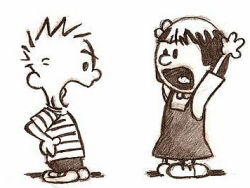 As personal trainers, our jobs for the most part are brain-dead simple. Sure, we studied, we have certifications and many of us went to college to learn what we know, but here’s the irony …
As personal trainers, our jobs for the most part are brain-dead simple. Sure, we studied, we have certifications and many of us went to college to learn what we know, but here’s the irony …
We rarely use any of that advanced info on a day-to-day basis.
But personal training isn’t ALL easy. The hard part has to do with everything BESIDES the training. And one of those hard parts is in our relationships with other people, particularly our clients.
And the problem areas in these relationships come down to having some tough, borderline confrontational conversations at times. Unless you’re planning to be a trainer from a computer in your bedroom (which funny enough, is very possible these days!), you’re going to need to have some of these conversations, and get good at having them.
The good news is that you will grow as a person because of them, and learn valuable interpersonal skills that will last you a lifetime. You learn to stand your own ground, set boundaries, but also be fair and diplomatic. If you’re feeling uncomfortable or unhappy with your training practice for whatever reason right now, it may be because of a failure to have one of these difficult conversations, and that’s why we’re going to go into them now.
DIFFICULT CONVERSATION NUMBER ONE – DELAYING THE PRICE CONVERSATION
 The first words out of any prospects mouth, whether it’s in person, on the phone, or through email, is always: “how much is it?”
The first words out of any prospects mouth, whether it’s in person, on the phone, or through email, is always: “how much is it?”
If you have any experience as a trainer, you’re probably nodding your head right now. This is a knee-jerk reaction from the prospect in almost every buying situation.
Why is that?
A lot of times, this is their failure mechanism making them want to quit before they even start. If the training is too “expensive” then they can always say to themselves that they couldn’t afford it, when in reality, the training is probably the best possible use of their money.
The first difficult conversation you need to have is telling them that you would like them to try out your training BEFORE you get into a price conversation. This can either be through an introductory training package; or if you have a model like bootcamps or semi-private sessions where you can give away free sessions, then go for it.
The reason for this is that once the prospect has got a taste of the product, they then know what they are paying for. This puts you in a much better negotiating position. Before that, they are only going on past experience to make their buying decision, and that’s something that’s completely out of your control.
So until your prospect has sampled your training, REFUSE to get into a price discussion with them. If you do, you will close a much higher percentage of your clients at much higher rates.
DIFFICULT CONVERSATION NUMBER TWO – RAISING PRICES ON CURRENT CLIENTS

Raising your prices is an obvious and often forgotten way to make more money.
This one can be a little tricky as well. This is when you’re asking for MORE money from an already existing client. This one is hard because as trainers we often bond with our clients, and therefore are afraid of rejection.
But I’ve found that this fear is completely unfounded. If you’re doing a good job and exceeding expectations by delivering a consistently high-quality product, then you don’t realize the powerful position you’re in. The truth is that your service becomes MORE valuable over time.
That being said, you should always inch your rates up to see what you can get away with. This is one of the best ways to prevent burnout as well. If you have something more to live up to in every session because you’re charging more, you’re going to have more challenges and more fun yourself.
DIFFICULT CONVERSATION NUMBER THREE – GROUPING CLIENTS OR CUTTING TRAINING TIMES

Small group training
Since as trainers we very often trade time for money, another thing you have to be very aware of is making the most of your time. You’ll find that once you have a certain number of clients, you don’t have enough time to train all of them, especially during peak hours.
If you’re spending a little time on your marketing every day, you’ll find yourself running into this probably fairly quickly. At this point you have only a couple of options: you can either cut your session times in half (and cut the price slightly if at all) or double your clients into groups of two or three (without cutting prices).
Again, fear of rejection is one of the major things stopping trainers from making this move. We instead try to juggle our schedules in un-natural ways, or end up training clients less frequently than they want because we don’t have the time.
But if you’re a trainer giving outstanding service, you’re in the drivers seat. For that reason, you have the right to step up and ask for what you deserve. You can either go ahead and cut that session in half to thirty minutes, or you can go and double book your clients into sessions.
This will naturally lead to a situation where you will have to hire an assistant or two, and eventually hand over the reins once you feel comfortable, and you can then have your employees do the training for you.
DIFFICULT CONVERSATION NUMBER FOUR: ASKING FOR REFERRALS

Referrals can grow and multiply very quickly
Even though on this and other industry blogs, you learn about a lot of new and funky marketing strategies, the top one still hasn’t changed: REFERRALS.
Most of the TOP-LEVEL TRAINERS I know don’t even have web sites or business cards. They just are impressive day in and day out, and people continue to bring them referrals. If you do have a good website, you’ll have a situation where you’ll become one of those obnoxious trainers that brags about how many clients they have, how busy they are, how much they’re charging, and how much money they’re making.
However, if you do need to bring your client load up very quickly in a short period of time, you can’t just wait for those referrals to come in. You have to step up and ask for them. Again, this can be a difficult conversation, but there’s no wiggle room here – your job is to get up to $100,000 pace as fast as possible, and nothing can stand in your way.
What that means is you are going to have to step up and ASK for referrals. The best time to do this is after you have delivered one of your A+ training sessions.
We all know that PUPPY DOG look our clients get when we’ve given them an excellent workout and they are extremely happy. It’s at this time that you need have the conversation with them …
Let them know that your business is dependent on you providing outstanding service, not looking for new clients. Ask them if there’s anyone else in their life they know that could benefit from the same outstanding service that you are giving to them. Do not hesitate to bring it up more than once.
And also bear in mind that you DO NOT need to BRIBE your clients for referrals by giving away a free sessions or anything like that – providing excellent service is enough.
What you can do is of course show your appreciation by giving them some kind of gift and a hand-written thank you note. Little things like this will ensure that you’ll never have a shortage of high-paying clients.
DIFFICULT CONVERSATION NUMBER FIVE: FIRING PROBLEM CLIENTS
 Firing a problem client can be a very difficult conversation to have, especially if you’re still going to be seeing this client around. But it’s also a necessary one that ever trainer needs to have on occasion.
Firing a problem client can be a very difficult conversation to have, especially if you’re still going to be seeing this client around. But it’s also a necessary one that ever trainer needs to have on occasion.
Sometimes the need to fire a client may be through no fault of their own. It may be that you’ve deciding to specialize, and this client no longer falls into your specialty. Or it could be because you’re trying to cut back on your training schedule, because through your referral and marketing efforts, you’re now overbooked. In that case, you may want to cut around the edges and eliminate clients in certain locations if you can’t make other arrangements.
I always recommend a trainer to be 25% overbooked, just for all the natural client drop-off that takes place. It’s better to have too many clients and juggle them and double-book them on occasion, rather than to have too few and see your income take a big dip.
The sign to drop a bad client is if you find yourself dreading going to see them every single time. Ask yourself, why is that? Is it something wrong with you? Or is it something negative on their end?
If you find that you’re going to be better served by dropping them, the best way to do it is like ripping off a band-aid. With the three hours a week you’ll free up from not seeing this problem client, you’ll have more time to spend on your marketing, either on your website, getting your website in front of more people, or in making deals to get more clients. So in the time you free up, you will be able to replace that client with at least one and maybe many more new, HIGH-QUALITY clients in just a couple of weeks.
SUMMARY
It’s pretty funny that the hard part of being a trainer has nothing to do with the training itself. But I always talk about training as being a JOURNEY, or an EXPERIENCE for the trainer that’s doing it. And such a large percentage of success depends on how you deal with other people, that this is one of the most valuable lessons you could ever learn.
——————————————————————————————————–
Want more articles on client relations? Then check these out:
How To Deal With Problem Personal Training Clients
Personal Training Clients | The Definitive Article
The Trainer/Client Relationship

Great post! These are good topics for new as well as experienced trainers to implement into their business.
Hey James – yeah, if we could sum it all up, it all comes down to having some balls!
Very high quality post!
Me and my friend (who’s been slaving away at the big box gym for months now) are planning on going into business with each other. I showed him the post and he can relate to what you said 100%.
I’m confident that if we follow the great advice here on Super Trainer we will be successful at whatever we set out to accomplish.
Thanks Kaiser! Keep it up!
Yeah Paul – the response to this post has been fantastic – I’m glad you got so much out of it –